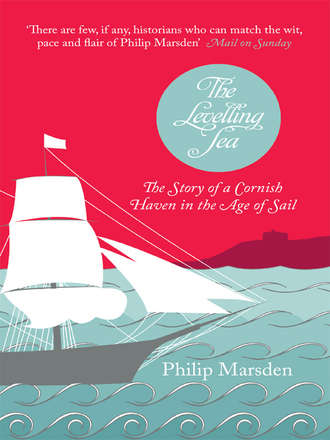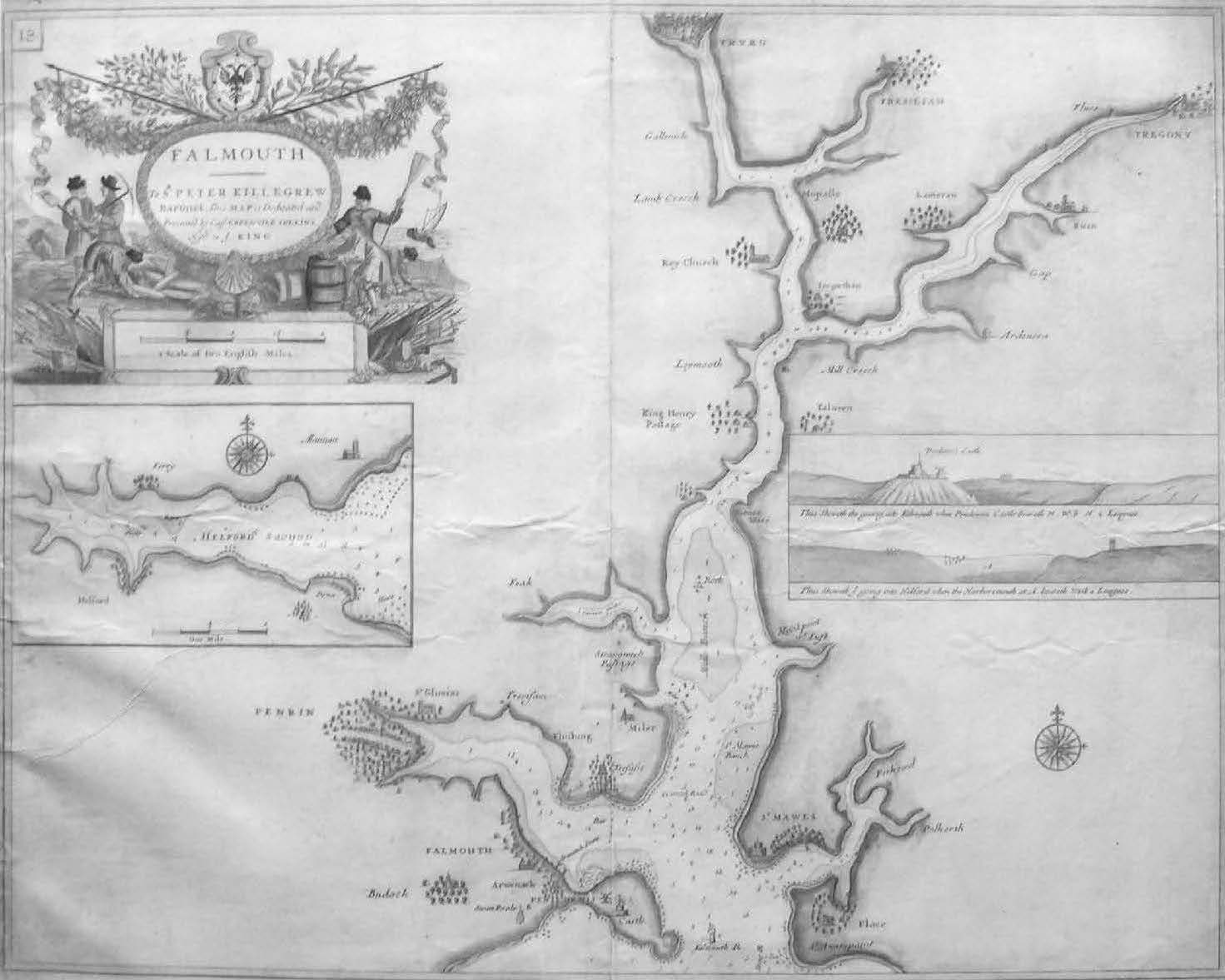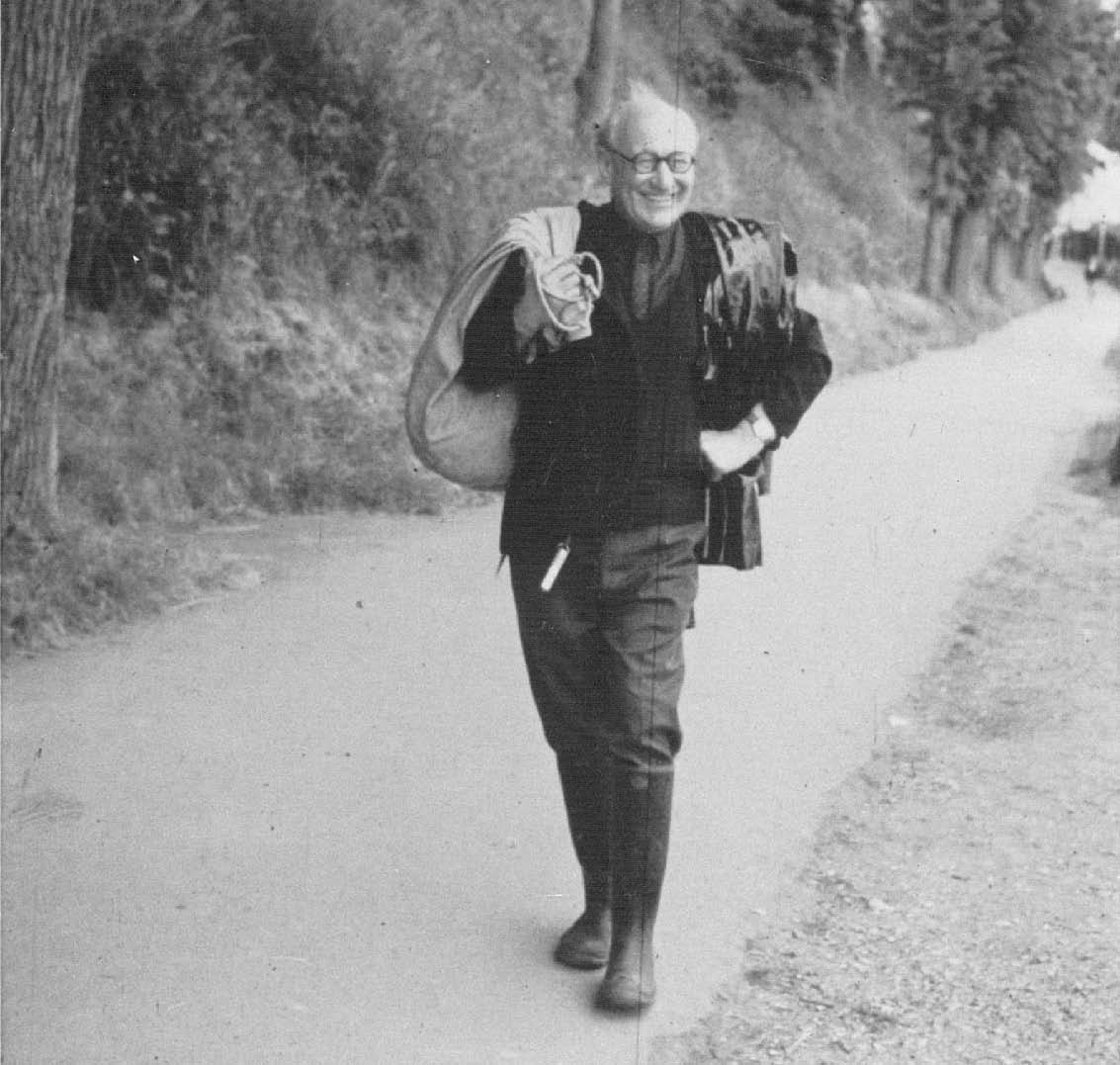
Полная версия
The Levelling Sea: The Story of a Cornish Haven in the Age of Sail

Philip Marsden
The Levelling Sea
The Story of a Cornish Haven in the Age of Sail
Nor is his thought on harp or on ring-taking,
On woman’s delight or on the world’s hope,
Nor on aught else save the tossing of waves:
He ever has longing who hastens on water.
From The Seafarer
(Trans. from the Anglo-Saxon by Jonathan A. Glenn)

To Arthur
List of Contents
Map of Falmouth
List of Illustrations
Part I
Chapter 1
Chapter 2
Chapter 3
Chapter 4
Chapter 5
Chapter 6
Chapter 7
Part II
Chapter 8
Chapter 9
Chapter 10
Chapter 11
Chapter 12
Part III
Chapter 13
Chapter 14
Chapter 15
Chapter 16
Chapter 17
Chapter 18
Chapter 19
Part IV
Chapter 20
Chapter 21
Chapter 22
Chapter 23
Chapter 24
Chapter 25
Epilogue
Acknowledgements
Notes
Bibliography
About the Author
Other Books by Philip Marsden
Credits
Copyright
About the Publisher
Map

Map of Falmouth (1693).
LIST OF ILLUSTRATIONS
‘Falmouth – To Sir Peter Killigrew, Baronet presented by Captain Greenville Collins (1693)’, engraving, 47 x 58 cms. © Falmouth Art Gallery Collection FAMAG:20003.13
Author’s grandfather. © Philip Marsden
Liberty’s stern. © Philip Marsden
Glasney College. © Llyfrgell Genedlaethol Cymru/The National Library of Wales
John and Elizabeth Killigrew, brass commemorative plaque in St Budock church. Reproduced from E.H.W Dunkin, The Monumental Brasses of Cornwall (Spottiswoode & Co., 1882)
Falmouth Haven. From Lord Burghley’s copy of Christopher Saxton’s Maps of the several counties of England. © The British Library Board. Royal MS. 18. D.III
Duke William and his Fleet Cross the Channel to Pevensey, from the Bayeux Tapestry (before 1082), wool embroidery on linen, by French School (11th century). © Musée de la Tapisserie, Bayeux, France/With special authorisation of the city of Bayeux/Giraudon/The Bridgeman Art Library
Ship illustration from Matthew Baker, Fragments of English Shipwrightry. Courtesy of the Pepys Library, Cambridge
Killigrew family tree
A map of the river Fal and its tributatries from a survey made in 1597, by Baptista Boazio. From H.M. Jeffrey, Early topography of Falmouth, JRIC vol. IX (1886). Courtesy of Cornwall Centre
Map of Smithwick (1615). From H.M. Jeffrey, Early topography of Falmouth, JRIC vol. IX (1886). Courtesy of Cornwall Centre
The Lizard Light-houses, Cornwall, by William Daniell. © Crown Copyright; UK Government Art Collection
‘Sovereign of the Seas’, by John Payne (1637). © National Maritime Museum, Greenwich, UK
Thomas Killigrew, by William Sheppard (1650). © National Portrait Gallery, London
‘A View of Falmouth Harbour’, by Hendrick Danckerts (circa 1678). © National Maritime Museum, Greenwich, UK
Detail from ‘Falmouth – To Sir Peter Killigrew, Baronet presented by Captain Greenville Collins (1693)’, engraving, 47 x 58cms. © Falmouth Art Gallery Collection. FAMAG:2003.13
Peter Killigrew. Frontispiece from Susan E. Gay, Old Falmouth: The Story of the Town from the Days of the Killigrews to the Earliest Part of the 19th Century (Headly Brothers, 1903)
The Killigrew Monument (The Pyramid Arwenack), by Unknown artist (19th century), oil on canvas, 49.5 x 63cms. © Falmouth Art Gallery Collection. FAMAG:1000.42
‘Fatte hogges, pretty oranges, strange crabs’. From Peter Mundy, The Travels of Peter Mundy in Europe and Asia, 1608–1667, vol. III, part I (Hakluyt Society, London 1919)
Avery the Pirate. CRO J/2277. Courtesy of the Cornwall Record Office
John Avery. From Captain Charles Johnson, A General History of the Robberies & Murders of the Most Notorious Pirates (Conway Maritime Press, 1998)
Armed guard for the Falmouth to London mail. © Mary Evans Picture Library/Bruce Castle Museum
Arwenacke House, Falmouth, Cornwall, by Unknown artist (1786). Engraver: Sparrow. Publisher: Hooper, S. Engraving, 15.3 x 20cms. © Falmouth Art Gallery Collection. FAMAG:1000.96
Cover of Samuel Kelly’s ‘Life & Voyages’, Vol. III. CRO X92. Courtesy of the Cornwall Record Office
Ship-worm (Teredo navalis). From Sir Charles Lyell, The Student’s Elements of Geology (Murray, 1871)
Jewish Cemetery, Falmouth. © Philip Marsden
Letter from George Croker Fox. By permission of Charles Fox
Books from the old G. C. Fox & Co. offices. © Philip Marsden
‘Sir Edward Pellew: Lord Exmouth’ after Sir Thomas Lawrence (c. 1797). © Hulton Archive/Getty Images
‘View of Falmouth & Sir J Borlase Warren’s prizes entering the harbour’, engraved by Thomas Medland (Bunney & Co., 1800). Courtesy of Cornwall Centre
The Indefatigable capturing La Virginie, by C. Sheppard (publisher) (1797). © National Maritime Museum, Greenwich, UK
The wreck of the East Indiaman Dutton at Plymouth Sound, 26 January 1796, by Thomas Luny (1821). © National Maritime Museum, Greenwich, UK
Extract from The Cornwall Gazette and Falmouth Packet, 7 March, 1801. Courtesy of the Courtney Libary (RIC), Truro
Grave of Joseph Emidy. © Philip Marsden
A View of Falmouth and places adjacent, by H. Michell (1806, published). Aquatint, 37 x 77cms. Lent by Cornwall Heritage Trust. © Falmouth Art Gallery Collection. FAMAG:L2000.4
‘Encounter with Robbers Near Kengawar’. From J. S. Buckingham, Travels in Assyria, Media, and Persia (Henry Colburn and Richard Bentley, 1830)
James Silk Buckingham by George Thomas Doo, after Unknown artist (1855), stipple engraving. © National Portrait Gallery, London
Falmouth, by Joseph Mallord William Turner, engraved by T. Lupton. © Tate, London 2011
Liberty’s bow. © Philip Marsden
From Falmouth Guide 1815. Courtesy of Cornwall Centre
Opening of the Falmouth and Truro railway (1863). © Illustrated London News Ltd/Mary Evans
Little Falmouth boatyard. © Philip Marsden
While every effort has been made to trace the owners of copyright material reproduced herein, the publishers would like to apologize for any omissions and would be pleased to incorporate missing acknowledgements in future editions.
CHAPTER 1
For more than twenty years I have lived beside the sea, in Cornwall, in a house with a square of grass in front of it, a hedge, a road, a low cliff and then a shingle beach sloping to the water. To the north and west, I can see the whitewashed cluster of cottages around the arm of the quay. Out towards the headland, the houses grow larger: a facade of homes built during the great age of sail by trader-captains who exchanged shifting decks for solid ground, prize-money for building-stone, ship-life for a safe contemplation of the horizon. Beyond these are the newer buildings, villas from the 1930s and the 1960s in their rescued patches of land, built also for sea-contemplation but by those who never knew the dog-watch nor the terror of working the tops. On the point itself, like a high-plains beast come down to drink, its silhouette magnificent against the evening sky, stands one of Henry VIII’s castles.
The headland opposite bears no buildings. A stand of pine covers its dipping entry into the sea. Gorse-spotted ground runs back from the point to a wood of holm and sessile oak. These two headlands, the one peopled and the other unpeopled, have been the borders of my life for two decades, open-ended, framing the vast-skied view from my studio window. Between them, stretching away into the distance, is the water.
During these years I have wasted weeks – months probably, when all added up – looking out at it. I have watched its constantly shifting shapes: the silvery slop after a blow, the sparkling mosaic in a winter sun, the slow swells of a southerly gale. I have listened to the rush of a week-long Atlantic storm, to the court of black-headed gulls, to the rummaging oystercatchers and roistering children. On windless nights, the air taut with expectation, I have woken to the rhythm of waves on the beach, each one hissing its message from centuries past, unintelligible and endlessly repeated. And during that time I have wondered this: what cumulative effect does such sea-proximity have? Does it offer anything more than a chance for idle gazing? Does it encourage a sense of restlessness, or complacency? Does it promote some spirit of equilibrium, a daily reminder that all things find their level? Or is its influence ultimately corrupting, creating the illusion of fulfilment always over the horizon, and in shipboard life an opportunity for living free from the constraints of the shore?
I have known this place since I was a child and although we came here for only a few weeks every year, it spurred an engagement with the world that nowhere inland could ever match. It was here that began a string of enthusiasms that filled my boyhood – first the beginnings of a rock collection (serpentine from the Lizard, quartzite pebbles from Samphire Island), then a passion for butterflies and moths (blues and commas and red admirals), birds, fishing and boats, always boats. Later, in my mid-twenties, in the wrong job and confounded by things I craved but could not name, I came here for a few weeks, to this house beside the Cornish sea, armed with one of those comforting and utterly useless phrases of intent – something like: to try to find the calm to work things out.
Calm! I remember the first morning. It was January. I had driven through the night and then watched dawn reshape the familiar form of the bay. I was used to it being full of boats, but there were none now. Instead the waters heaved in a grey easterly, bursting against the harbour wall and flopping back against the swells. Everything was in flux, the sea surface, the rushing clouds, the gulls flitting and arcing in the wind. By the next day, the sky was clear, the wind had gone and the sea was still. For weeks I wrote and walked and wallowed in the weather shifts and felt surprised by each one. But I was aware, too, of a growing sense of urgency, a sea-prompted rage against the rush of time. With the summer coming, I went off to East Africa before returning for another winter writing it up. That set up a pattern that continued for many years, a decade-long odyssey that followed its lone and dusty course through the Middle East and Eastern Europe. Sometimes I spent a whole year away, in Addis Ababa, Jerusalem and Moscow. But always I came back here, to this house beside the sea.
When I married, I thought it must be over, that solipsistic sea-life, but we stayed. We lived here for another ten years and now for various reasons we are moving inland (partly to do with a run-down farmhouse that has stolen our hearts). We are leaving this village, with its face turned to the water, and people say constantly: ‘You will miss the sea.’ And my instinct is to resist. I won’t miss it. But how can I know? If I haven’t been able to understand the presence of the sea, what chance is there of understanding its absence?
One October, in the brief decades between the wars, a young man arrived in this village. He was a Scot. With him was an English wife whose naval connections went back for generations, but it was he who was the yachtsman, he who hired the boat and took it out into the harbour – between the twin headlands. So struck was he by that day, by the village and by the little boat, that he came back the next year, and the year after that, and each year for the next half a century. He brought his children every summer, to sail a small gaff-rigged sloop named Ratona (‘female rat’ in Spanish) and each evening wrote up the day in a series of leather-bound logs; embossed on their plain covers was the single word Ratona. If it was a particularly good day, or the first sail for one of his grandchildren, he would carefully flush the blue ink from his fountain pen and replace it with red.
In one of these logs, from the early 1960s, is this red-letter entry: ‘Philip, two years old, left in the arms of his mother as we rowed aboard, wailed until we gave in.’ I was bundled with the storm-sails in the forepeak and although I do not remember that first time, I do recall the hours spent there later, half sleeping and half waking, looking up at the underside of the foredeck with its white gloss scattered with rosettes of black mould. I can still hear the lap of the water and smell the rough folds of the Egyptian cotton sail-cloth beneath me.
One golden evening when I was 9 or so, my grandfather and I were out alone in Ratona. He handed me the helm. As we beat back and forth across the Carrick Roads, heeling to one of those northerlies that often follows a hot day, he pointed up at the sails and for the first time explained the principle of sailing – the miracle of hull-shape and sail-set that enables a boat, obliquely, to sail towards the wind. I watched him in that moment, with his hand arced against the icing-white mainsail, describing the technique with a cracked softness in his voice that he used only when he spoke of certain people, and of certain periods in his life. I realised then, in a way I could not articulate, that this was as powerful as any human attachment, this love of the sea.
But I know, too, that ‘love of the sea’ is not strictly accurate. Mariners do not love the sea. Love for the sea is something you feel from the shore. You can admire the sea from a deck; you can be drawn to it, awed and terrified by it. If you are out on the water, your affection is not for the shifting mass all around the hull, but for the hull itself. What seamen feel for their vessel is something that elevates it high above the inanimate. It is, said Conrad, ‘profoundly different from the love that men feel for every other work of their hands’.
No other arena of human endeavour has proved quite so challenging as the ocean. It has driven individuals and whole nations to do remarkable things – innovative, courageous and brutal. I have seen plenty of men, and it is almost always men, who are ill at ease on land, dazed, whose shore life is a mess; but put them on a boat, and they are transformed. They become athletes, commanders, strategists, heroes. The skills needed on a boat are unlike any on land, because everything is different at sea.
Take the language. Many think that nautical language is some dialect generated by cultural divergence long ago, in an age when mariners and landsmen rarely came into contact with each other. They think the modern sailor perpetuates it like some quaint outdated code, the lexical equivalent of dressing in eighteenth-century costume. But each sea-term has no translation in land language, because there is no equivalent on land. Every strange force the sea exerts, every quirk of tidal stream and every reef and twist of shoreline, every tackle-snapping, deck-swamping, broaching, pooping, pitch-poling and sinking, and every lone drowning, booms out the same warning: you should not be out here!
Yet it was the ability to build ships for passage, for oceanic voyages, to transport commodities and people, to line their sides with cannon, that shaped the modern world. More than any other agent, ships spread political power, ideas, goods and technology. Naval dominance – achieved first by the Spanish, then the Dutch and the British – decided whose ships went furthest, and who brought the greatest wealth home.
The maritime states’ struggle was one of dominance on the ocean rather than of the ocean. Their success came not by taming the sea but by recognising its essential hostility, and working with its constraints. Basil Greenhill, chronicler of the end of wind-driven shipping, spoke of the age of sail as the ‘the age of collaboration’: the sailing ship represents ‘the height of [man’s] achievement in adapting the existing forces of nature … as opposed to the achievement of changing their direction and function’.
Sometimes reading the accounts of the sea battles of that time, the engagements involving privateers or ships-of-the-line, you have the sense less of the total war of the twentieth century than of some watery medieval tournament, a grand and deadly game in which each side, however pitiless, is bound by natural rules – the no-go areas to windward, the fatal advantage of the weather gage.
In the recent, post-industrial attraction to the wild, a yearning driven above all by the realisation of our distance from it, the sea is rarely mentioned. Yet it is perhaps the only true wilderness. You cannot manipulate the sea, you cannot cultivate it. Efforts to ‘farm’ its margins have in most cases proved disastrous. Fishermen are not agriculturalists; to find their equivalent on land you have to go back beyond written history, to hunter-gatherer groups of the Mesolithic age. The sea teaches the lesson every ecologist urges us to understand about the natural world: that it cares nothing for us, that it will survive us. Try to impose your will upon it and it will destroy you. Swim through it or pass over it in a boat, and you leave not a trace. In time it will, like sand over the works of Ozymandias, close over every brick, every avenue and every last relic of our civilisation.
That is the wisdom of the sea, its essential paradox. It quickens us, extends us, prompts feats of innovation and courage, then washes them all away. No trace remains; man and mountain yield to the levelling force of the sea. In its omnipotence, its beauty and its purity, the sea is the earthly manifestation of the divine. Building a vessel and crossing a body of water is a transcendent achievement, and afterwards nothing in this life quite compares.
During my first winter on the Fal estuary, my grandfather would telephone frequently from his home in Hampshire. He was now 90. He wanted to know exactly what the weather was doing, about the sea state, what ships had been going in and out of Falmouth. No detail was too trivial. Spring tides or neaps? Is the ferry running? He examined the weather maps and asked: has the wind backed yet down there? Has the cold front passed over you? He quizzed me about all those boats he knew, the people of the shore, the fishermen and part-time gardeners, the summer sailors and retired boat-builders. And then one storm-dark December afternoon, he rang and asked me: would I be kind enough to do something for him? Would I go up the river, have a look at Ratona?
In the dusk I walked through the cliff-top fields to where Ratona was wintering. She stood on legs at the rim of a tidal pool. Her bowsprit pushed up towards the serpentine roots of a group of Monterey pines; behind them was St Just churchyard, a mossy necropolis of slate and granite headstones. Two mooring warps looped out from Ratona’s stern, down into the ebbing tide. Twice a day the water rose and fell around her, keeping her boards tight with moisture. The church clock’s chimes rang out across the creek every quarter of an hour.
Climbing down to the muddy foreshore, I ran my hand along the curve of her waterline – the green topsides and scum-crusted red of her anti-fouling. I looked at the chain-plate, and the place where her mast should be and the winter cover stretched down tight over the ridge-pole, and was overwhelmed by a sense of the vanished past, of a hundred half-remembered scenes – squinting up the mast to check the lift of the cotton luff, gazing at the lee gunwale as the water rushed past it, rowing ashore in some hidden cove and looking at her at anchor, or lying again in the forepeak, cushioned by sail-cloth. With a squelch, I yanked my boots out of the mud, and climbed back up to the churchyard. The winter wind combed through the pines. It was almost dark.
I rang my grandfather that evening and told him Ratona was in fine shape. ‘Good,’ he said. ‘That’s splendid …’ His words sounded distant. Just two weeks later, at his Hampshire home, he developed pneumonia and died.
When I was very young, I thought there were two grandfathers, one in Hampshire, in woollen tie and leather-elbowed jacket, listening to music in his book-lined study. The other one lived in Cornwall, and was wilder, and more adventurous, and more appealing to a young boy. He wore sea-boots and salt-crusted trousers; he draped sails from the banisters to dry; he tinkered with tackle and rope, rowed his dinghy standing up. The memorial service for the first took place in a flint-walled church near the River Test, a dark-suited parade of family and surviving friends. It was several weeks later when there was a ceremony for the other grandfather. His ashes were brought to St Just. Only three of us stood with the vicar at the graveside. The wind sighed in the Monterey pines. We placed his ashes among the roots. Just yards below him, as if he was some Norse hero buried with his boat, lay Ratona.

My grandfather.
CHAPTER 2
I have been away for a few weeks and now I go down to the water. Summer rain has left my upturned dinghy with green fur around the gunwales. I scrub it down, haul it to the beach and into the shallows. I sense the sudden lightness as the stern lifts and bobs free. The rowlocks clunk-clunk into the silence of the Percuil river. On the far side, beneath a flocculent strip of woods, lies the 21-foot harbour launch I bought some years ago with a friend. In the 1920s she was built as a liberty-boat, a solid workhorse of a naval craft, used to ferry men and supplies around Chatham harbour. Traditionally these launches took sailors ashore, from ship-bound service to shore-bound freedom – hence the name. For me, it has exactly the opposite meaning.
In the rounded clinker sides, the spade-like rudder, the steep and solid stem, I like to imagine centuries of maritime evolution. I picture the shipwright between the wars, circled by fresh-faced groms, instructing them in laying the keel, fixing the garboards, conjuring the lines outwards and upwards with each riveted strake, working as countless generations had before him, without plans, with no more than a practised eye and a couple of notions – to make the bilge a little deeper this time, the quarter a little fuller, and having the instinctive means to do it. A War Department registration is carved into the transom: WD 347. We call her Liberty.

Liberty’s stern.
She is the last moored boat, at the far edge of a forest of spars. Beyond is a crescent of wooded shoreline and beach that now, towards the bottom of the tide, dries to mud. One or two punts lie on their sides, the sag of their painters hung with fronds of channelled wrack and eel grass. I am always amazed by the stillness of this place. Even in a rising gale, with gusts racing down from the slopes to scurry across the water, with the halyards beating out warnings from the masts in the river, the pool retains a calm so intense that I often sit here long after I have packed away the gear, engulfed by its presence.
It is thought that this small inlet was among the earliest-used anchorages of the Fal, the natural refuge of a ship groping in from the storms of the Western Approaches, running for the lee of St Mawes harbour, round into the mouth of the Percuil, then round again to settle on its side in this muddy cul-de-sac – tin ships from the Gironde, Breton traders, and those who brought no worldly goods, who kept within them no thought of return to their native ports. Long before the estuary’s main shoreside settlements had appeared, monastic communities were measuring out their days here, with prayer and fishing and contemplation.








